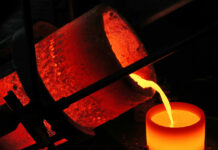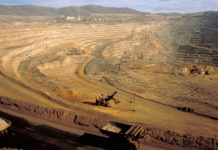
[miningmx.com] — SHAREHOLDERS in Hong Kong-listed Wing Hing International will vote on August 19 on whether to invest up to R4bn in the purchase of two marginal South African gold operations.
These are the former Jeanette mine in the Free State which was shut down in 1955 and the “Evander project’ which consists of the decommissioned No 6 shaft at Harmony’s Evander mining complex plus the adjacent, undeveloped Twistdraai project.
Wing Hing will obtain these mines through the acquisition of 87% of unlisted junior Taung Gold, which bought these assets from Harmony in September last year for just R300m.
Wing Hing will be renamed Taung Gold International on completion of the acquisition.
At a press conference held in Hong Kong on Thursday – following the release of a circular to Wing Hing shareholders as well as scoping studies on both projects – Taung Gold CEO Neil Herrick repeated his highly optimistic outlook for both projects.
According to Herrick, Taung Gold “will develop into one of the lowest-cost producers in the South African gold environment when its projects move into production”.
Jeanette is forecast to produce up to 380,000 ounces of gold annually at an average cash operating cost of $322/oz, while Evander is forecast to produce up to 267,000oz of gold annually at an average cash operating cost of $397/oz.
Let’s put that into perspective. Nobody – not even the surface treatment operators – currently produces gold in South Africa at those cost levels.
AngloGold Ashanti – which is widely held to own the best gold mines in the country -reported an average total cash cost of $637/oz for the March quarter, with individual mine performances ranging from $516/oz to $1,202/oz.
Gold Fields reported an average total cash cost for its mines of $966/oz in the March quarter.
DRDGold reported March quarter cash costs for its surface retreatment operations as being $875/oz for Ergo; $975/oz for Crown and $591/oz for Blyvooruitzicht.
But the best comparison must be with Harmony given that both Jeanette and the Evander assets are ones that Harmony sold, clearly believing they were not worth developing in comparison to the group’s other projects both in South Africa and in Papua New Guinea (PNG).
Harmony reported an average cash cost of $970/oz for the March quarter with costs on individual mines ranging from $760/oz to $1,484/oz. The group also reported a cash cost of $966/oz for gold produced from its open-cast Hidden Valley operation in PNG.
Herrick described the two projects as “shallow’, but that’s by South African gold mining standards. Forecast mining depths range from 700m to 2,300m.
Herrick defended the projections, stating that the infrastructure required for Jeanette and Evander would be tailored specifically to their production profiles.
“You will see a cost structure that is fundamentally different to that reflected by much of the rest of the South African industry where many mines are reaching the end of their lives. Those projected costs are not unreasonable.”
There’s also a large question mark over the redevelopment of Jeanette concerning the Khaki Shale formation which can cause severe support problems for the mine workings . That’s why Jeanette was never fully developed by founder Anglo American.
TECHNICAL CHALLENGES
Herrick described this as a “technical challenge” and said “an independent technical committee has been established to review mining strategy for specific geotechnical areas and to mitigate risk”.
He added it only affected part of the Jeanette lease and had been “successfully dealt with at neighbouring mines”.
That’s correct but geological evidence is the Khaki Shale band is at its thickest – and therefore most dangerous – in the north of the Free State goldfields where Jeanette and the neighbouring Loraine mine are situated.
Problems with Khaki Shale band forced the early closure of the Loraine No 1 shaft.
What this all amounts to has to be the most optimistic claims over the redevelopment of old South African gold mines since Central Rand Gold (CRG) came on the scene in 2007.
CRG claimed it would produce 1 million ounces of gold annually from 2012 by re-opening various old mineworkings on the Central Witwatersrand.
It would be unfair to write off Taung up-front as destined to become the same kind of unmitigated disaster that CRG turned into, but investors have to balance the incredibly optimistic forecasts being made against the harsh realities of actually delivering such projects when Taung Gold comes looking for funds.
Herrick estimated the peak funding requirement for Jeanette at $603m (about R4.2bn) which will be reached in 2016 and for Evander at $315m (about R2bn) to be reached in 2018.
Initial gold production is expected from Evander in the first quarter of 2015.
Herrick stressed the extensive experience he and partners Rudolph de Bruin and Igor Levental have in the gold mining business. All three would become executive directors of the new company if the Wing Hing deal is voted through.
Said Herrick: “We are staying with the company because we want to take it forward.”
Wing Hing chairperson Jack Li commented he was confident the deal would “bring substantial returns to our shareholders in the long run”.









